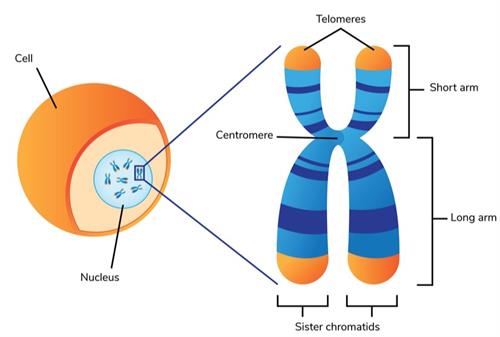
PUMPA - SMART LEARNING
எங்கள் ஆசிரியர்களுடன் 1-ஆன்-1 ஆலோசனை நேரத்தைப் பெறுங்கள். டாப்பர் ஆவதற்கு நாங்கள் பயிற்சி அளிப்போம்
Book Free DemoCells must constantly divide to make new cells to replace old, worn-out cells for an organism to grow and function efficiently. DNA must stay intact and equally distributed among cells during cell division. In most of cell divisions, chromosomes are an essential part of ensuring DNA is correctly copied and distributed. Even yet, mistakes do happen from time to time.
Chromosome number or shape changes in new cells might cause major problems. Defective chromosomes are made up of joined fragments of damaged chromosomes.
Example:
One type of leukaemia and some other cancers in humans are caused due to a defect in chromosomal number.
Sister chromatids are two identical strands that makeup chromosomes, which are thin, long, and thread-like structures. The centromere is what holds them together. Each chromatid is made up of chromonema, a spirally coiled thin structure. The chromonema is made up of chromomeres, which are bead-like structures that run the length of the chromonema. DNA, RNA, chromosomal proteins (histones and non-histones), and specific metallic ions make up chromosomes. The chromosome is supported structurally by these proteins. The following four regions make up a chromosome:
- Primary constriction
- Secondary constriction
- Telomere
- Satellite
1. Primary constriction
The primary constriction or centromere is the point where the two arms of a chromosome meet. During cell division, the centromere is where spindle fibres attach to chromosomes.
2. Secondary constriction
At any position along the chromosome, some chromosomes have secondary constriction. They are called the nuclear zone or nucleolar organiser.
Important!
The nuclear zone or nucleolar organiser is the formation of the nucleolus in the nucleus.
3. Telomere:
Telomere refers to the chromosome's terminal. Each chromosome has a polarity that prevents it from joining the chromosome next to it. The chromosomes are maintained and stabilised by it.
4. Satellite
Some chromosomes have a satellite, an extended knob-like appendage at one end of the chromosome. Sat-chromosomes are chromosomes that have satellites attached to them.

The structure of chromosome
Important!
Do you know!
Every cell's telomeres act as an ageing clock.
Telomeres are protective nucleotide sequences that are present at the ends of chromosomes. Every time a cell divides, it gets shorter. When telomeres get too short of completing their job causes our cells to age.